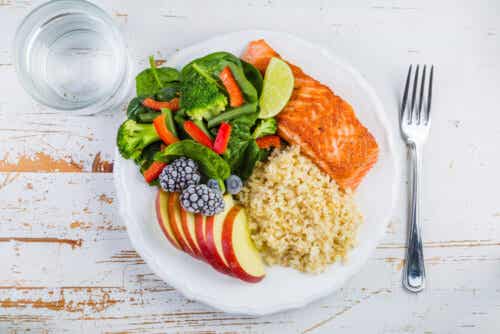How to Plan a Healthy Family Menu

Reconciling work, children, household chores, free time, shopping, and meals is a challenge. And, although it may seem complicated, it’s a matter of knowing what the consumption recommendations are and getting organized. Here’s how to plan a healthy family menu and avoid conflicts at the table.
How to plan a healthy family menu
First of all, you need to understand what it means to eat healthily and to include those food groups that are part of your diet (omnivorous, vegetarian, or vegan).
A healthy diet consists of a wide variety of fresh, seasonal, and local foods. In addition, it provides all the nutrients necessary for the proper functioning of your body. The food groups of this diet are:
Vegetables
- Vegetables. These are the basis of the diet, as stated in the Harvard Plate. They’ve to be included in the two main meals and in greater proportion. In case you prefer to eat a single dish, the recommended volume is half of the plate.

- Fruits. Their minimum consumption is two to three servings, which is equivalent to a medium-sized piece, such as an apple or orange; two small units, such as tangerines or plums; or a handful, in the case of grapes or red fruits. In addition, we recommend you prioritize whole and fresh pieces and that at least one of them is acidic. You can have them at the end of lunch or dinner, or between meals.
Protein foods
- Legumes and derivatives. Within this group, we find lentils, chickpeas, beans, peas, soybeans, tofu, and tempeh. The minimum recommended consumption is three times a week.
- Eggs. They contain proteins of high biological value since they provide all the essential amino acids. They’re also an excellent source of vitamin B8. They’re usually recommended three to four times a week, although they can be included daily.
- Fish, mollusks, and shellfish. They stand out for their high EPA and DHA content, which contribute to the reduction of cardiovascular risk. And also iodine, which regulates metabolism. The recommended consumption is three to four times a week.
- Meat. This includes chicken, turkey, poultry, pork, and beef. Experts recommend consuming them three to four times a week, the best options being chicken and other poultry.
The complements
- Cereals and tubers. These include rice, pasta, potato, quinoa, millet, oat flakes, corn, sweet potato, yucca, etc. It’s always best that cereals be whole grain.
- Dairy products or plant-based drinks. Although they’re considered essential, their consumption depends on each culture and country.
- Olive oil and derivatives. These are essential for cooking and obtaining tastier dishes. They’re the main source of fat in the diet. However, there’s a tendency to reduce their consumption, as we overlook the fact that olive oil provides Essential Fatty Acids (EFA), which are found in the cellular membrane that protects cells against deterioration.
- Nuts and seeds. These are the ideal complement to oil, since they’re rich in EFAs, magnesium, vitamin E, and fiber. A handful of 20-30 g and a tablespoonful, respectively, is enough. In addition, they don’t contain cholesterol and help to reduce cholesterol levels in the blood.
- Water. This is the fundamental drink, as water makes up 70 percent of your body.

Organize the week by food groups
Now that you’re aware of the healthy foods that your body needs, you need to distribute them throughout the week. So, take a template, write down the daily vegetables and then do the same with the different protein foods (eggs, legumes, fish, and meat) following the recommended consumption patterns. Remember that you can increase the frequency of the ones you like the most, either because you’re vegetarian or because you prefer fish.
Value your children’s opinion when planning a healthy family menu
Are there certain foods you’d rather not eat? Are there foods you absolutely can’t stand? Well, the same thing happens to children. So, let them choose a dish and even help you cook or do the shopping.
Then turn the food into attractive, tasty, and healthy dishes. For example, using vegetables, egg, and rice, you can create a delicious veggie ratatouille (zucchini, bell peppers, and onion) with egg and rice. Add spices such as thyme, nuts, and use olive oil.
And so on, every day of the week. If you can’t come up with any ideas, consult a recipe book. There are also websites where you can enter the ingredients you have on hand or in mind, and you’ll get a variety of recipe options.
Choosing the right cooking techniques
The most recommended cooking techniques are steaming, boiling (recommended for cereals, legumes, and tubers), grilling, sautéing, and baking. Stews are also a good option, as the sauce or seasoned juice enhances flavor and adds juiciness.
Adapt the portions of each food to the needs of each person
Finally, it’s important that you take into account each person’s individual appetite, since the quantities are indicative, as you can see in the following table:
| Children | Adolescents and adults | |
| Vegetables | 100 – 150 g | 150 – 200 g |
| Fruits | 100 – 150 g | 150 – 200 g |
| Potatoes | 100 – 150 g ( 1 median unit) | 200 – 250 g |
| Rice / pasta | 50 – 60 g (2 – 3 handfuls) | 60 – 80 g |
| Eggs | 60 g (1 small unit) | 60 – 120 g (1 – 2 median units) |
| Legumes | 50 – 80 g | 150 – 200 g |
| Fish | 50 – 80 g | 125 – 150 g |
| Meat | 50 – 80 g | 150 – 200 g |
| Milk | 200 ml (1 cup) | 200 ml (1 cup) |
| Yogurt | 125 ml (1 unit) | 125 ml (1 unit) |
| Cheese | 25 – 30 g semi-cured and cured cheese (1 – 2 slices) 40 – 60 g fresh cheese (2 – 3 slices) | 30 – 40 g semi-cured and cured cheese (2 slices) 40 – 60 g fresh cheese (2 – 3 slices) |
| Oil | 20 – 30 ml (2 – 3 soup cups) | 30 – 40 ml (3 – 4 soup cups) |
| Nuts and dried fruit | 20 g (ground up to 3 years old) | 20 – 30 g |
Conclusion: how to plan a healthy family menu
As you can see, by having some basic knowledge, you can learn how to plan a healthy family menu. In addition, once you’ve created your template by food groups, it’ll be easier for you to modify the dishes so that they’re as varied as possible.
Reconciling work, children, household chores, free time, shopping, and meals is a challenge. And, although it may seem complicated, it’s a matter of knowing what the consumption recommendations are and getting organized. Here’s how to plan a healthy family menu and avoid conflicts at the table.
How to plan a healthy family menu
First of all, you need to understand what it means to eat healthily and to include those food groups that are part of your diet (omnivorous, vegetarian, or vegan).
A healthy diet consists of a wide variety of fresh, seasonal, and local foods. In addition, it provides all the nutrients necessary for the proper functioning of your body. The food groups of this diet are:
Vegetables
- Vegetables. These are the basis of the diet, as stated in the Harvard Plate. They’ve to be included in the two main meals and in greater proportion. In case you prefer to eat a single dish, the recommended volume is half of the plate.

- Fruits. Their minimum consumption is two to three servings, which is equivalent to a medium-sized piece, such as an apple or orange; two small units, such as tangerines or plums; or a handful, in the case of grapes or red fruits. In addition, we recommend you prioritize whole and fresh pieces and that at least one of them is acidic. You can have them at the end of lunch or dinner, or between meals.
Protein foods
- Legumes and derivatives. Within this group, we find lentils, chickpeas, beans, peas, soybeans, tofu, and tempeh. The minimum recommended consumption is three times a week.
- Eggs. They contain proteins of high biological value since they provide all the essential amino acids. They’re also an excellent source of vitamin B8. They’re usually recommended three to four times a week, although they can be included daily.
- Fish, mollusks, and shellfish. They stand out for their high EPA and DHA content, which contribute to the reduction of cardiovascular risk. And also iodine, which regulates metabolism. The recommended consumption is three to four times a week.
- Meat. This includes chicken, turkey, poultry, pork, and beef. Experts recommend consuming them three to four times a week, the best options being chicken and other poultry.
The complements
- Cereals and tubers. These include rice, pasta, potato, quinoa, millet, oat flakes, corn, sweet potato, yucca, etc. It’s always best that cereals be whole grain.
- Dairy products or plant-based drinks. Although they’re considered essential, their consumption depends on each culture and country.
- Olive oil and derivatives. These are essential for cooking and obtaining tastier dishes. They’re the main source of fat in the diet. However, there’s a tendency to reduce their consumption, as we overlook the fact that olive oil provides Essential Fatty Acids (EFA), which are found in the cellular membrane that protects cells against deterioration.
- Nuts and seeds. These are the ideal complement to oil, since they’re rich in EFAs, magnesium, vitamin E, and fiber. A handful of 20-30 g and a tablespoonful, respectively, is enough. In addition, they don’t contain cholesterol and help to reduce cholesterol levels in the blood.
- Water. This is the fundamental drink, as water makes up 70 percent of your body.

Organize the week by food groups
Now that you’re aware of the healthy foods that your body needs, you need to distribute them throughout the week. So, take a template, write down the daily vegetables and then do the same with the different protein foods (eggs, legumes, fish, and meat) following the recommended consumption patterns. Remember that you can increase the frequency of the ones you like the most, either because you’re vegetarian or because you prefer fish.
Value your children’s opinion when planning a healthy family menu
Are there certain foods you’d rather not eat? Are there foods you absolutely can’t stand? Well, the same thing happens to children. So, let them choose a dish and even help you cook or do the shopping.
Then turn the food into attractive, tasty, and healthy dishes. For example, using vegetables, egg, and rice, you can create a delicious veggie ratatouille (zucchini, bell peppers, and onion) with egg and rice. Add spices such as thyme, nuts, and use olive oil.
And so on, every day of the week. If you can’t come up with any ideas, consult a recipe book. There are also websites where you can enter the ingredients you have on hand or in mind, and you’ll get a variety of recipe options.
Choosing the right cooking techniques
The most recommended cooking techniques are steaming, boiling (recommended for cereals, legumes, and tubers), grilling, sautéing, and baking. Stews are also a good option, as the sauce or seasoned juice enhances flavor and adds juiciness.
Adapt the portions of each food to the needs of each person
Finally, it’s important that you take into account each person’s individual appetite, since the quantities are indicative, as you can see in the following table:
| Children | Adolescents and adults | |
| Vegetables | 100 – 150 g | 150 – 200 g |
| Fruits | 100 – 150 g | 150 – 200 g |
| Potatoes | 100 – 150 g ( 1 median unit) | 200 – 250 g |
| Rice / pasta | 50 – 60 g (2 – 3 handfuls) | 60 – 80 g |
| Eggs | 60 g (1 small unit) | 60 – 120 g (1 – 2 median units) |
| Legumes | 50 – 80 g | 150 – 200 g |
| Fish | 50 – 80 g | 125 – 150 g |
| Meat | 50 – 80 g | 150 – 200 g |
| Milk | 200 ml (1 cup) | 200 ml (1 cup) |
| Yogurt | 125 ml (1 unit) | 125 ml (1 unit) |
| Cheese | 25 – 30 g semi-cured and cured cheese (1 – 2 slices) 40 – 60 g fresh cheese (2 – 3 slices) | 30 – 40 g semi-cured and cured cheese (2 slices) 40 – 60 g fresh cheese (2 – 3 slices) |
| Oil | 20 – 30 ml (2 – 3 soup cups) | 30 – 40 ml (3 – 4 soup cups) |
| Nuts and dried fruit | 20 g (ground up to 3 years old) | 20 – 30 g |
Conclusion: how to plan a healthy family menu
As you can see, by having some basic knowledge, you can learn how to plan a healthy family menu. In addition, once you’ve created your template by food groups, it’ll be easier for you to modify the dishes so that they’re as varied as possible.
All cited sources were thoroughly reviewed by our team to ensure their quality, reliability, currency, and validity. The bibliography of this article was considered reliable and of academic or scientific accuracy.
- Agencia Salud Pública de Cataluña (ASPCAT). (2017) Guía de la alimentación saludable en la etapa escolar. Barcelona.
- Universidad de Harvard. El plato para Comer Saludable.
- Sociedad Española de Alimentación Comunitaria (SENC). (2018) Guía de la alimentación saludable para atención primaria y colectivos ciudadanos.
This text is provided for informational purposes only and does not replace consultation with a professional. If in doubt, consult your specialist.








